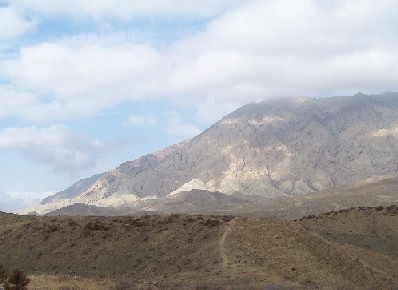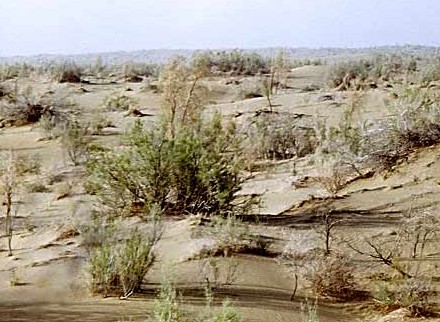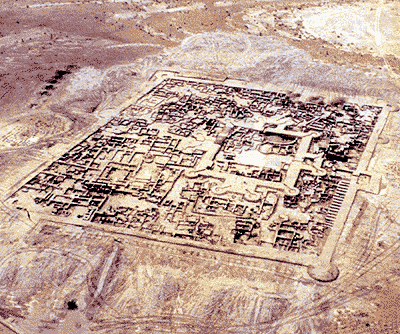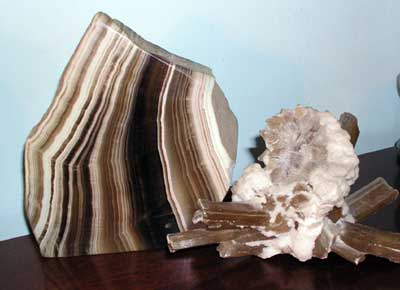Nature Reserves of Turkmenistan
Topic: Environment & ecology
The Amudarya nature reserve includes the ecosystems of tugai forests in the Amudarya River valley and adjoining desert areas. This nature reserve provides habitats for 48 species and subspecies of mammals, and 203 species and subspecies of birds. Here 1,040 species of higher plants grow. Among vertebrate animals there are rare species, such as the Central Asian gazelle, Bukhara deer, ratel, otter, marble teal, osprey and others. Among fish species, there are greater and lesser Amudarya false shovelnose sturgeons, and pike chub. The Amudarya nature reserve manages the Kelif natural preserve that incorporates lake ecosystems in South-East Turkmenistan and is a favorable place for the wintering of migratory and aquatic birds.
The Badkhyz nature reserve , and the Badkhyz region proper, include ecosystems of hilly plateaus at the piedmont of the Paropamiz, the northernmost range of the Hindukush. The territory of the nature reserve supports 40 species of mammals, 250 species of birds, 34 species of reptiles. Among them are the Central Asian gazelle, Turkmen mountain sheep, onager, striped hyena, caracal, leopard, short-toed eagle, golden eagle, and others.
The vegetation in Badkhyz includes 1,050 varieties of vascular plants (442 genera and 76 families) of which more than 75 species and subspecies are endemic. The nature reserve incorporates 3 natural preserves (all established in 1956):
Chemenibit (floodplain-river, the summer drinking place for onagers);
Kyzyldjar (piedmont, the drinking place for mammals and birds);
Pulikhatum (piedmont, the drinking place for mammals and birds).
 The Kopetdag nature reserve was set up for the conservation and integrated study of the mountain forest ecosystems. The protected territory spreads over high and medium mountains of the Central Kopetdag, i.e. between meridians crossing the Archman railway station in the west, and the Gyaurs station in the east. The nature reserve provides habitats for 68 species of mammals and 280 species of birds. More than 960 species of plants grow here. The nature reserve incorporates two natural preserves established in 1976: Kalininsk (mountains), and Meana-Chaacha (piedmont).
The Kopetdag nature reserve was set up for the conservation and integrated study of the mountain forest ecosystems. The protected territory spreads over high and medium mountains of the Central Kopetdag, i.e. between meridians crossing the Archman railway station in the west, and the Gyaurs station in the east. The nature reserve provides habitats for 68 species of mammals and 280 species of birds. More than 960 species of plants grow here. The nature reserve incorporates two natural preserves established in 1976: Kalininsk (mountains), and Meana-Chaacha (piedmont).
The larger territory of the Kaplankyr nature reserve is occupied by the Kaplankyr clay plateau-like upland, the southern spur of the Ustyurt Plateau. According to the botanical geography, the protected territory lies at the junction of northern and southern deserts. Here are found 26 species of mammals, 147 species of birds, and 918 species of higher plants. Protected here are rare species of animals, such as the Central Asian gazelle, the Ustuyrt mountain sheep, ratel, etc.; among higher plants – the Khiva thistle, Turkmen tulip, Antonia’s gypsophila, Karelin sand acacia, and other 55 endemic species. In addition, enormous populations of saiga antelopes that migrate here from Karakalpakstan in the winter are also protected in the nature reserve. The Kaplankyr nature reserve incorporates two natural preserves: Sarykamysh (established in 1980; lake-coastal ecosystems) and Shakhsenem (established in 1984; stony desert).
The main directions of activity in the Kugitang nature reserve are the conservation and restoration of the mountain ecosystems in the Southern Pamir-Alai. The Kugitangtau range forms the border between the Mountain-Central Asian and Iranian biogeographic provinces, and is characterized by specific physiographical conditions and the original flora and fauna. 22 species of mammals and 80 species of birds were registered in the nature reserve. About 1,000 species of higher plants, among which 40 are endemic, have been found in the nature reserve. The Kugitang nature reserve incorporates 3 natural preserves (all established in 1986):
Karlyuk (karst; protection of unique subsurface caves, the world’s only population of the Kugitang blind char);
Khodjapil (mountain forest; conservation of Zarafshan juniper, “Dinosaurs Plateau”, screw-horned mountain goat, and others);
Khodja-Burdji-Belend (mountain forest; protection of pistachio areas).
 The Karakum Desert occupies the area of about 35 million ha, or more than 80% of the whole territory of Turkmenistan. According to its geological and natural conditions, the Karakum can be divided into three large parts: Northern or Zaunguz, Central or Lowland, and South-Eastern Karakum. The latter incorporates the Repetek State Biosphere Reserve where 20 species of mammals and 23 species of birds live. The total flora of higher plants growing here includes 269 species belonging to 206 genera and 84 families. Of 132 species of aboriginal plants in the Repetek nature reserve 42 species (31.8%) are endemic for the Karakum and Kyzylkum deserts.
The Karakum Desert occupies the area of about 35 million ha, or more than 80% of the whole territory of Turkmenistan. According to its geological and natural conditions, the Karakum can be divided into three large parts: Northern or Zaunguz, Central or Lowland, and South-Eastern Karakum. The latter incorporates the Repetek State Biosphere Reserve where 20 species of mammals and 23 species of birds live. The total flora of higher plants growing here includes 269 species belonging to 206 genera and 84 families. Of 132 species of aboriginal plants in the Repetek nature reserve 42 species (31.8%) are endemic for the Karakum and Kyzylkum deserts.
The Syunt-Khasardag nature reserve includes ecosystems of the Western Kopetdag mountains (dry subtropics) and neighboring plains. Here, 37 species of mammals and 217 species of birds are found. Flora of the Western Kopetdag includes 1,266 species of higher plants, which belong to 233 genera and 500 families; among these, 150 species are endemic. The nature reserve incorporates one mountain natural preserve, the Syunt-Khasardag (established in 1990). It is separated from the Central part of the nature reserve in order to improve social and economic conditions of the population in the Garrygala etrap (district).
The desert ecosystems, dry subtropics, and marine shallow bays in the southeastern coast of the Caspian are included into the Khazar nature reserve. It consists of two parts, Essenguly and Krasnovodsk. It was set up in 1968 on an area of 192,300 ha. This nature reserve is included in the list of aquatic and wetland habitats of the international significance that are under protection of the Ramsar International Convention. The Khazar nature reserve provides the habitat for 18 species of mammals and 372 species of birds. Of the bird fauna, nearly a half is waterfowl and near-water birds, which is a specific feature of the Khazar nature reserve (more than 85% of its territory covers the water areas, bays, and sea).
Posted by countryturkmenistan
at 12:18 PM
Updated: Monday, 4 December 2006 12:38 PM



 The excavations in Margiana will make reconsider views on the remote past of humankind and fully reveal a real picture of the remote past of the remarkable Turkmen land located in the centre of Asia, on the crossroads of the ancient caravan routes and modern transcontinental communication lines. The participants of the International Scientific Conference “Ancient Margiana – a New Centre of the World Civilisation” held in the Mary Velayat and that completed its work have come to such conclusion.
The excavations in Margiana will make reconsider views on the remote past of humankind and fully reveal a real picture of the remote past of the remarkable Turkmen land located in the centre of Asia, on the crossroads of the ancient caravan routes and modern transcontinental communication lines. The participants of the International Scientific Conference “Ancient Margiana – a New Centre of the World Civilisation” held in the Mary Velayat and that completed its work have come to such conclusion.  Turkmenistan is rich in the gemstones deposits and occurrences. Many of Turkmen gemstones are well-known to collectors and connoisseurs in our country and abroad. The most famous one is the Karluk marble onyx deposit located in the Gaurdag-Kugitang region in the very east of Turkmenistan. By its colour and beauty of natural ornaments marble onyx has no analogues all over the world. Onyx is a banded variety of chalcedony. The colours of its bands are brown (varying from semi-transparent yellow to dark brown) and white. Onyx occurs in the caves as various dripstones and it is used for making souvenirs – caskets, candlesticks, vases. The stones of remarkable beauty are used for making jewelry. The beautiful druses of gypsum, calcite and aragonite crystals occur in the Kugitang caves.
Turkmenistan is rich in the gemstones deposits and occurrences. Many of Turkmen gemstones are well-known to collectors and connoisseurs in our country and abroad. The most famous one is the Karluk marble onyx deposit located in the Gaurdag-Kugitang region in the very east of Turkmenistan. By its colour and beauty of natural ornaments marble onyx has no analogues all over the world. Onyx is a banded variety of chalcedony. The colours of its bands are brown (varying from semi-transparent yellow to dark brown) and white. Onyx occurs in the caves as various dripstones and it is used for making souvenirs – caskets, candlesticks, vases. The stones of remarkable beauty are used for making jewelry. The beautiful druses of gypsum, calcite and aragonite crystals occur in the Kugitang caves. 
